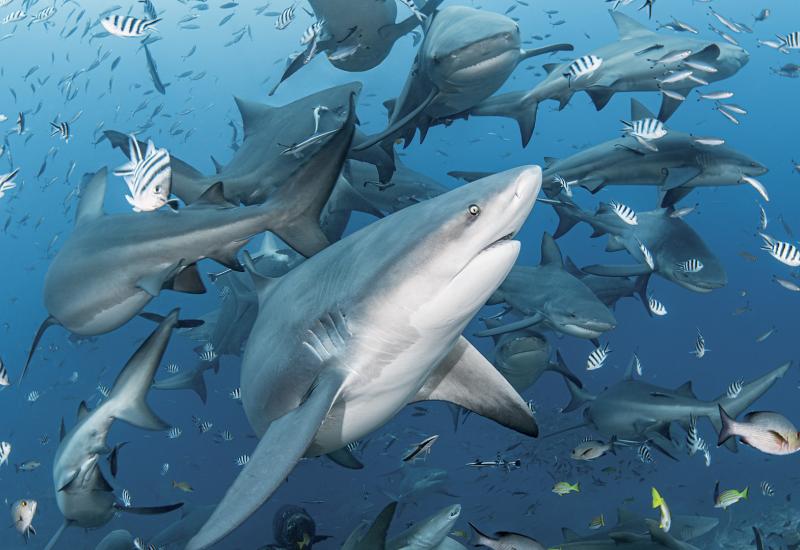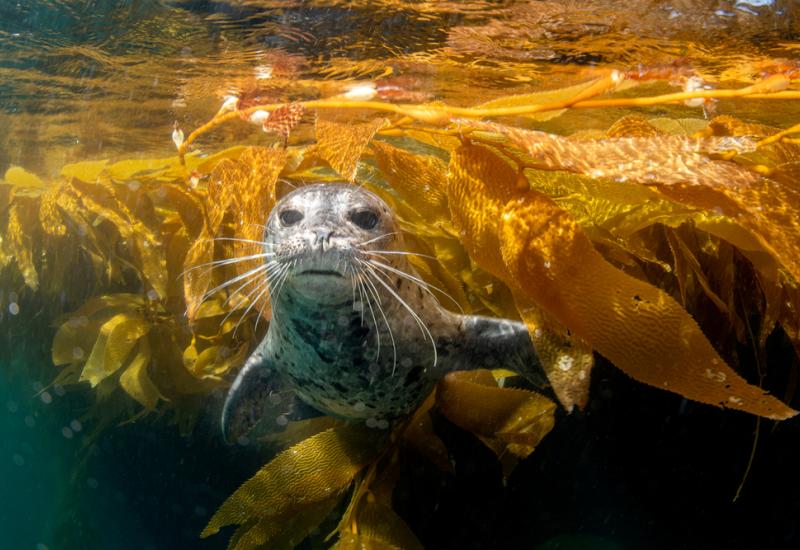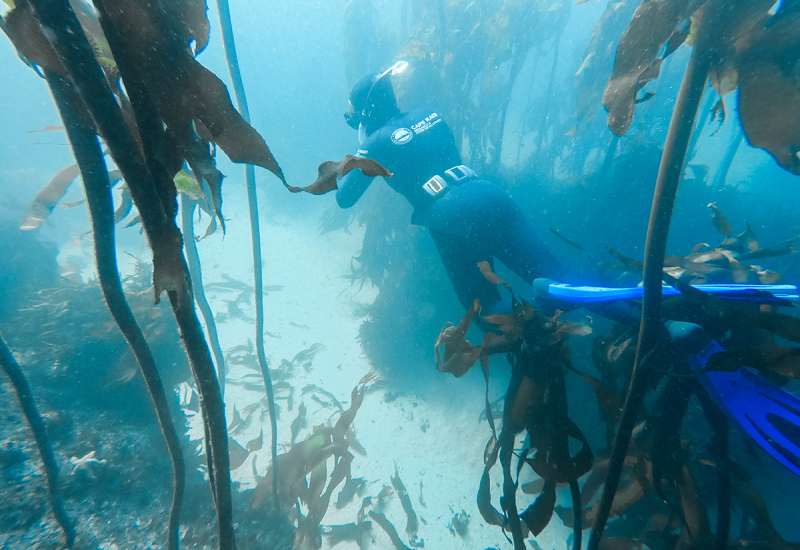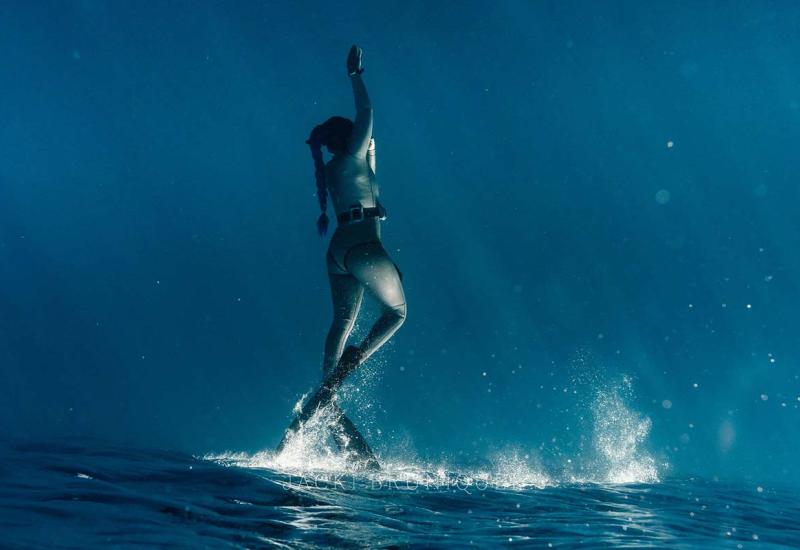Fast Food: South Africa’s Annual Sardine Run

Photos and Story By Jason Heller
What It Takes Technically, any diver with an advanced certification can dive the Sardine Run, but you should be in good shape for swimming, have excellent buoyancy control, and experience with currents and colder water. All diving is in “blue water” with no navigational or depth references. Wear dark colors, preferably all black, and ensure that your entire body is covered with no skin showing. While there is an emphasis on safety, you’ll be diving among feeding sharks and it’s a wise idea to not call attention to yourself. Bright silver cameras should also be covered in black neoprene or other material that can conceal what might otherwise be recognized as a giant sardine. Scientists can only theorize what causes the sardines to “run” in such massive numbers; they’ve been able to make a correlation between water temperature and the currents changing direction. None of that matters to the local fishermen whose nets gorge past capacity, or to the thousands of predators who wait for the three-month food orgy. Or, really, to the divers who throw caution (and thousands of dollars) to the wind to dive the Sardine Run. Not all get the chance though. Surf entries, rough seas, variable weather, limited visibility and fickle baitballs are all factors you must contend with. The divers who arrived a week earlier weren’t as lucky as I. While the explosive action was occurring offshore, surf entries were impossible due to unusually low tides. This game of chance is all part of the adventure.
We hold our footing to keep the bow steady as each wave crests, inching the small tender forward off the sand until the outboard engine can gain purchase. The captain gives the order for us to hop aboard, guns the engine and we’re shot like a cannon over the incoming surf. As the boat passes through the breakers, I gaze at the towering cliffs and rolling hills of South Africa’s wild coast. Launching a boat in 5-foot waves is a wild start, but it’s going to get wilder. In a few hours I’ll be diving within a boiling, writhing mass of predation on an epic scale. And in five days I’ll have seen more dolphins, sharks and whales than in all my previous diving years combined. The annual Sardine Run is one of nature’s great wonders. Arguably the largest migratory event on Earth (rivaling the Serengeti’s wildebeest migration), for three months each year hundreds of millions of Southern African pilchards — or sardines — aggregate in massive shoals off South Africa’s east coast and ride the current as it charges north. Each shoal of sardines might as well have a giant bull’s eye on it, as everything from dolphins to Cape gannets to whales and sharks chows down on the movable feast. For divers, the only trick is to find a baitball –– a large group that breaks away from the main shoal –– and get in its way. On this day, though, it proves to be more difficult than I imagined. Even one of the fathers of diving the Sardine Run, captain and dive leader Walter Bernardis seems to be having difficulty as our small group of divers, in full gear and cameras at the ready, cruises for miles out to sea and up the coast, escorted by humpback whales and small pockets of birds. Bernardis is looking for the telltale sign of a baitball: swarms of Cape gannets dive-bombing a concentrated area of otherwise vast open ocean. So we rely on a microlight plane to guide us. It patrols the sky above in a search pattern, radioing the position of the birds. A crescendo of anticipation builds with every passing pod of dolphins. And then we see it: Judgment Day on an expanse of ocean. Thousands of Cape gannets speckle the sky, with hundreds more dive-bombing the seething sea below. Bernardis brings the boat in close, just a few short fin kicks away from the action. Bernardis has given us a thorough briefing on shore, but he sees fit to impart some final words of wisdom before I back-roll and descend on my first feeding frenzy. “Don’t look like food,” he says. “Don’t act like food.”
5 Tips for the Fast Action Sardine Run 1. Be prepared. Preset camera settings before jumping in. Have strobes turned on, preset apertures to f/8 and shutter speeds on 1/125 or higher to freeze movement. Initial settings will allow reasonable RAW captures should the action come unexpectedly. Shoot, review your histograms and adjust accordingly throughout the dive. Your one crack at glory might come only once; don’t blow it by being unprepared. 2. Wide glass for big returns. Fisheyes and wide-angle zooms allow plenty of light to keep ISOs low, focus quickly and deliver adequate depth of field when wide apertures are necessary for correct exposure. Wide-angle zooms also allow more photo opportunities compared with a fisheye or wide-angle prime. If you have one, use it. 3. Get in close. While wide-angle lenses capture entire scenes like a frenzied baitball, they can also suppress drama when used improperly. For maximum impact, get close. This might require nerves of steel, but close proximity to the action and a little luck produce powerful, compelling images. 4. Light you can handle. Strobes offering a wide angle of coverage and fast recycle times are the way to go. If two strobes prove cumbersome while chasing the action, consider diving with one. Feeling confident? Hand-hold the left strobe for greater control and more-even lighting. However you play it, use diffusers. They’ll soften harsh light from flashes and spread the beam for better coverage. 5. Embrace focus technology. Activate your camera’s continuous-servo auto-focus mode (AI servo mode on a Canon), which helps predict focus of fast-moving subjects and facilitates their tracking. High-end cameras also offer dynamic area AF options to help improve focus responsiveness as well. Used together, your success rate for in-focus captures can skyrocket, even when your framed composition changes unexpectedly. Doug Sloss is a photographer and writer specializing in the marine environment. He has also produced a handful of educational DVDs, including his latest release, Adobe Photoshop CS4 for the Underwater Photographer. Learn more at www.underwaterphotoshop.com .
Want the Complete Package? Slip the new Canon 1D MK IV into an Aquatica housing for the Canon 1DS MKIII. It’s the perfect fit that also allows video capture in full 1080p HD for those who also want to bring home action in motion. Combined with a pair of low profile Inon Z240s strobes that feature 110 degree coverage (with diffuser) and a superfast recycle time of 1.6 seconds, and you’ll have a top setup inside that swirling baitball!
The moment I submerge, I’m bombarded with sights and sounds and feels. The chirps and clicks of hunting dolphins create the soundtrack to the initial experience, and the Cape gannets hit the water with such force that I feel miniature shockwaves pulse through my body. Sardine scales float in the water column, indicating that I’m swimming in the right direction; otherwise the ocean is a featureless abyss. Dolphins careen past me, and dozens of sharks patrol the edge of my limited visibility. The shockwaves get stronger and more frequent. Finally a dark, large, amorphous shape appears. The main shoal of sardines remains deep below the surface. Common dolphins form small packs like wolves beneath the mass of fish, separating portions of the shoal and forcing the fish toward the surface by blowing walls of bubbles under and around them. Instinctively the sardines form tight balls as a means of protection, but it’s clearly not working. Cape gannets drop from the sky like feathery rain, attacking the sardines at the top of the baitball, which sits between 30 and 60 feet deep. With the dolphins taking turns to charge the baitball from below, the sardines have nowhere to hide. The baitball undulates –– evasive maneuvering that only delays the inevitable under this onslaught. Of course all the activity attracts sharks. In the first 10 minutes, I see six of the seven species that frequent the run: bronze whalers, oceanic blacktips, dusky sharks, silky sharks, “raggies” (sand tigers) and bull sharks. (The only local species that didn’t grace this meal was the tiger shark.) I’m comfortable around sharks, but my first feeding frenzy at the Sardine Run is starting to test my steely nerves. My initial feelings of excitement are now tinged with a bit of fear, as large sharks throw themselves into the baitball with reckless abandon, while others emerge from the walls of fish at breakneck speed. Smaller groups of sardines periodically use me to evade the relentless predators, engulfing me as part of the baitball. The largest sharks in the Bacchanalia, duskies brazenly swim toward me, only to veer away at the last second as I ward them off by pushing my dome port against their snouts. Although my camera’s viewfinder represents a false sense of remote observation of the bedlam in front of me, I am acutely aware of the fast-moving open mouths with razor-sharp teeth that could accidentally bite an arm or hand or leg. Incidents occur every year –– usually minor and always accidental, the risk is part and parcel with this great diving spectacle. This is organized chaos, beautiful in its unpredictability. As quickly as it began, it ends. The last sardine is eaten; nothing’s left but scales and fish oil. We caught the last hour of a baitball that likely took several hours from start to finish. We board the tender, quiet for the first few minutes after the sensory overload, and head back to shore in time for a midafternoon lunch at the lodge and an evening of pinching ourselves to make sure we weren’t dreaming. The next several days continue to bring good fortune. Each morning’s successful beach launch is followed by just an hour or two of searching for the elusive baitballs. We always find one, and it’s always breathtaking. It isn’t until the third day though that I appreciate how each baitball takes on a life of its own –– some are small and frenetic, others large and hypnotic; some are shallow, some are deep. Several baitballs were stationary, while others were mobile, including one that forced us to swim along with it for more than a mile. Sharks aren’t abundant on every dive, but when they arrive in numbers, their presence upstages everything else. That is, everything but the crown jewel of the Sardine Run: the Bryde’s whale. In a week of dives, I encounter this distinctive-looking whale –– with its long head –– on three separate baitballs. Each torpedo-shaped whale, easily 40 feet in length, plunges into the baitball at its largest and most dense, simply gliding through, mouth agape, consuming hundreds if not thousands of fish in a single pass. The whale is surprisingly stealthy for its size. It isn’t until the very last second that I can see a 12-foot tail fin passing overhead, revealing the silent stalker as it made its way to the feast. Our final baitball brings us several less-stealthy Bryde’s whales, seeking the attention of the underwater paparazzi that were all too obliged to comply. I ascend with a near-empty tank, giddy from the surreal experience, and we head back to shore for the last bumpy beach landing. Nothing could ruin the memories of a week on the Sardine Run though. “Hang on tight,” said Bernardis as he pauses to time the entry over the waves. “I learned this one on Baywatch.”
Need to Know
Getting There -- Fly into the Johannesburg International Airport via South African Airways and connect into Durban, where your dive operator can arrange land transportation to the launch point (up to a five-hour drive). All Sardine Run diving is done from day boats. There are several launch points including Mbotyi River, Port St. Johns and East London, depending on the operator you choose. When to Go -- The Sardine Run occurs between May and July each year. The run is unpredictable, so longer stays are recommended to maximize the opportunity to catch the action. Dive Conditions -- Visibility is unpredictable and can range from 15 to 50 feet. The South African winter also means that weather and surf conditions can vary from day to day, hour to hour. Riding back to shore over large swells is not uncommon. A 5 mm wetsuit should suffice, but if you tend to get cold easily, pack the 7 mm. Operators -- There are several dive operators who offer Sardine Run diving, but for safety reasons it is best to go with those who have the most experience. Walter Bernardis’ African Water Sports ( www.africanwatersports.co.za ) and SEAL ( www.sea-air-land.com ) both offer packages and launch from Mbotyi River Lodge ( www.mbotyi.co.za ). Price Tag -- African Water Sports offers a seven-day package that includes five days of diving, accommodations and food for approximately $2,990; 11-day trips are approximately $5,390. Topside Adventures -- Mbotyi Lodge arranges Land Rover tours to visit waterfalls, cliffs and gorges during dry time between dives.
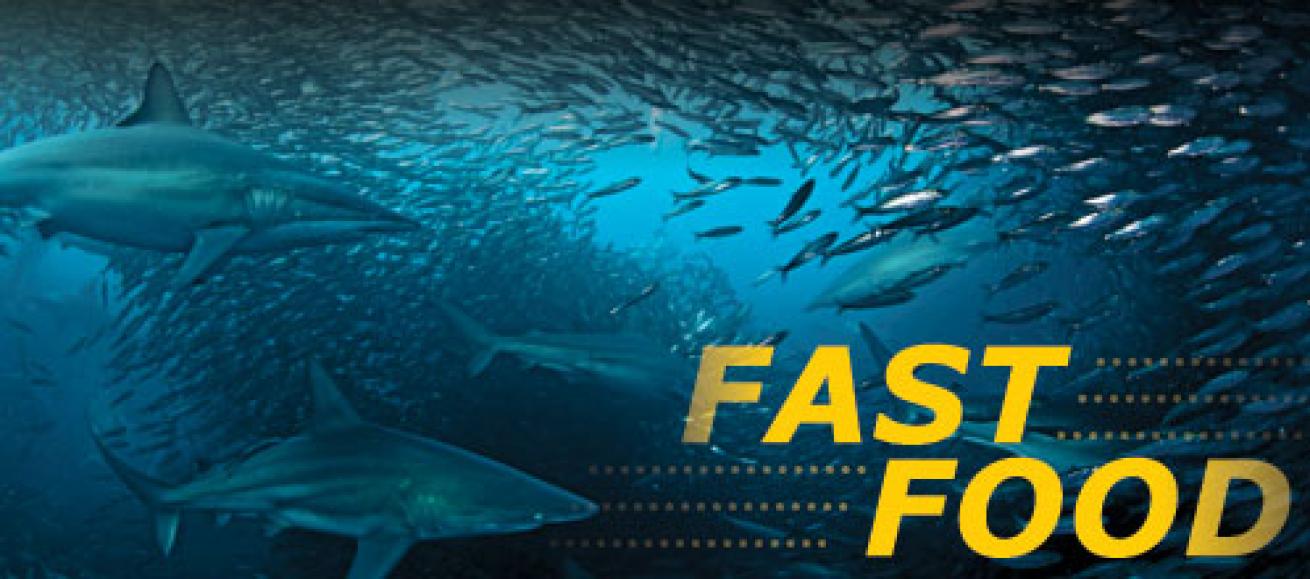
Photos and Story By Jason Heller
What It Takes Technically, any diver with an advanced certification can dive the Sardine Run, but you should be in good shape for swimming, have excellent buoyancy control, and experience with currents and colder water. All diving is in “blue water” with no navigational or depth references. Wear dark colors, preferably all black, and ensure that your entire body is covered with no skin showing. While there is an emphasis on safety, you’ll be diving among feeding sharks and it’s a wise idea to not call attention to yourself. Bright silver cameras should also be covered in black neoprene or other material that can conceal what might otherwise be recognized as a giant sardine. Scientists can only theorize what causes the sardines to “run” in such massive numbers; they’ve been able to make a correlation between water temperature and the currents changing direction. None of that matters to the local fishermen whose nets gorge past capacity, or to the thousands of predators who wait for the three-month food orgy. Or, really, to the divers who throw caution (and thousands of dollars) to the wind to dive the Sardine Run. Not all get the chance though. Surf entries, rough seas, variable weather, limited visibility and fickle baitballs are all factors you must contend with. The divers who arrived a week earlier weren’t as lucky as I. While the explosive action was occurring offshore, surf entries were impossible due to unusually low tides. This game of chance is all part of the adventure.
We hold our footing to keep the bow steady as each wave crests, inching the small tender forward off the sand until the outboard engine can gain purchase. The captain gives the order for us to hop aboard, guns the engine and we’re shot like a cannon over the incoming surf. As the boat passes through the breakers, I gaze at the towering cliffs and rolling hills of South Africa’s wild coast. Launching a boat in 5-foot waves is a wild start, but it’s going to get wilder. In a few hours I’ll be diving within a boiling, writhing mass of predation on an epic scale. And in five days I’ll have seen more dolphins, sharks and whales than in all my previous diving years combined. The annual Sardine Run is one of nature’s great wonders. Arguably the largest migratory event on Earth (rivaling the Serengeti’s wildebeest migration), for three months each year hundreds of millions of Southern African pilchards — or sardines — aggregate in massive shoals off South Africa’s east coast and ride the current as it charges north. Each shoal of sardines might as well have a giant bull’s eye on it, as everything from dolphins to Cape gannets to whales and sharks chows down on the movable feast. For divers, the only trick is to find a baitball –– a large group that breaks away from the main shoal –– and get in its way. On this day, though, it proves to be more difficult than I imagined. Even one of the fathers of diving the Sardine Run, captain and dive leader Walter Bernardis seems to be having difficulty as our small group of divers, in full gear and cameras at the ready, cruises for miles out to sea and up the coast, escorted by humpback whales and small pockets of birds. Bernardis is looking for the telltale sign of a baitball: swarms of Cape gannets dive-bombing a concentrated area of otherwise vast open ocean. So we rely on a microlight plane to guide us. It patrols the sky above in a search pattern, radioing the position of the birds. A crescendo of anticipation builds with every passing pod of dolphins. And then we see it: Judgment Day on an expanse of ocean. Thousands of Cape gannets speckle the sky, with hundreds more dive-bombing the seething sea below. Bernardis brings the boat in close, just a few short fin kicks away from the action. Bernardis has given us a thorough briefing on shore, but he sees fit to impart some final words of wisdom before I back-roll and descend on my first feeding frenzy. “Don’t look like food,” he says. “Don’t act like food.”
5 Tips for the Fast Action Sardine Run 1. Be prepared. Preset camera settings before jumping in. Have strobes turned on, preset apertures to f/8 and shutter speeds on 1/125 or higher to freeze movement. Initial settings will allow reasonable RAW captures should the action come unexpectedly. Shoot, review your histograms and adjust accordingly throughout the dive. Your one crack at glory might come only once; don’t blow it by being unprepared. 2. Wide glass for big returns. Fisheyes and wide-angle zooms allow plenty of light to keep ISOs low, focus quickly and deliver adequate depth of field when wide apertures are necessary for correct exposure. Wide-angle zooms also allow more photo opportunities compared with a fisheye or wide-angle prime. If you have one, use it. 3. Get in close. While wide-angle lenses capture entire scenes like a frenzied baitball, they can also suppress drama when used improperly. For maximum impact, get close. This might require nerves of steel, but close proximity to the action and a little luck produce powerful, compelling images. 4. Light you can handle. Strobes offering a wide angle of coverage and fast recycle times are the way to go. If two strobes prove cumbersome while chasing the action, consider diving with one. Feeling confident? Hand-hold the left strobe for greater control and more-even lighting. However you play it, use diffusers. They’ll soften harsh light from flashes and spread the beam for better coverage. 5. Embrace focus technology. Activate your camera’s continuous-servo auto-focus mode (AI servo mode on a Canon), which helps predict focus of fast-moving subjects and facilitates their tracking. High-end cameras also offer dynamic area AF options to help improve focus responsiveness as well. Used together, your success rate for in-focus captures can skyrocket, even when your framed composition changes unexpectedly. Doug Sloss is a photographer and writer specializing in the marine environment. He has also produced a handful of educational DVDs, including his latest release, Adobe Photoshop CS4 for the Underwater Photographer. Learn more at www.underwaterphotoshop.com .
Want the Complete Package? Slip the new Canon 1D MK IV into an Aquatica housing for the Canon 1DS MKIII. It’s the perfect fit that also allows video capture in full 1080p HD for those who also want to bring home action in motion. Combined with a pair of low profile Inon Z240s strobes that feature 110 degree coverage (with diffuser) and a superfast recycle time of 1.6 seconds, and you’ll have a top setup inside that swirling baitball!
The moment I submerge, I’m bombarded with sights and sounds and feels. The chirps and clicks of hunting dolphins create the soundtrack to the initial experience, and the Cape gannets hit the water with such force that I feel miniature shockwaves pulse through my body. Sardine scales float in the water column, indicating that I’m swimming in the right direction; otherwise the ocean is a featureless abyss. Dolphins careen past me, and dozens of sharks patrol the edge of my limited visibility. The shockwaves get stronger and more frequent. Finally a dark, large, amorphous shape appears. The main shoal of sardines remains deep below the surface. Common dolphins form small packs like wolves beneath the mass of fish, separating portions of the shoal and forcing the fish toward the surface by blowing walls of bubbles under and around them. Instinctively the sardines form tight balls as a means of protection, but it’s clearly not working. Cape gannets drop from the sky like feathery rain, attacking the sardines at the top of the baitball, which sits between 30 and 60 feet deep. With the dolphins taking turns to charge the baitball from below, the sardines have nowhere to hide. The baitball undulates –– evasive maneuvering that only delays the inevitable under this onslaught. Of course all the activity attracts sharks. In the first 10 minutes, I see six of the seven species that frequent the run: bronze whalers, oceanic blacktips, dusky sharks, silky sharks, “raggies” (sand tigers) and bull sharks. (The only local species that didn’t grace this meal was the tiger shark.) I’m comfortable around sharks, but my first feeding frenzy at the Sardine Run is starting to test my steely nerves. My initial feelings of excitement are now tinged with a bit of fear, as large sharks throw themselves into the baitball with reckless abandon, while others emerge from the walls of fish at breakneck speed. Smaller groups of sardines periodically use me to evade the relentless predators, engulfing me as part of the baitball. The largest sharks in the Bacchanalia, duskies brazenly swim toward me, only to veer away at the last second as I ward them off by pushing my dome port against their snouts. Although my camera’s viewfinder represents a false sense of remote observation of the bedlam in front of me, I am acutely aware of the fast-moving open mouths with razor-sharp teeth that could accidentally bite an arm or hand or leg. Incidents occur every year –– usually minor and always accidental, the risk is part and parcel with this great diving spectacle. This is organized chaos, beautiful in its unpredictability. As quickly as it began, it ends. The last sardine is eaten; nothing’s left but scales and fish oil. We caught the last hour of a baitball that likely took several hours from start to finish. We board the tender, quiet for the first few minutes after the sensory overload, and head back to shore in time for a midafternoon lunch at the lodge and an evening of pinching ourselves to make sure we weren’t dreaming. The next several days continue to bring good fortune. Each morning’s successful beach launch is followed by just an hour or two of searching for the elusive baitballs. We always find one, and it’s always breathtaking. It isn’t until the third day though that I appreciate how each baitball takes on a life of its own –– some are small and frenetic, others large and hypnotic; some are shallow, some are deep. Several baitballs were stationary, while others were mobile, including one that forced us to swim along with it for more than a mile. Sharks aren’t abundant on every dive, but when they arrive in numbers, their presence upstages everything else. That is, everything but the crown jewel of the Sardine Run: the Bryde’s whale. In a week of dives, I encounter this distinctive-looking whale –– with its long head –– on three separate baitballs. Each torpedo-shaped whale, easily 40 feet in length, plunges into the baitball at its largest and most dense, simply gliding through, mouth agape, consuming hundreds if not thousands of fish in a single pass. The whale is surprisingly stealthy for its size. It isn’t until the very last second that I can see a 12-foot tail fin passing overhead, revealing the silent stalker as it made its way to the feast. Our final baitball brings us several less-stealthy Bryde’s whales, seeking the attention of the underwater paparazzi that were all too obliged to comply. I ascend with a near-empty tank, giddy from the surreal experience, and we head back to shore for the last bumpy beach landing. Nothing could ruin the memories of a week on the Sardine Run though. “Hang on tight,” said Bernardis as he pauses to time the entry over the waves. “I learned this one on Baywatch.”
Need to Know
Getting There -- Fly into the Johannesburg International Airport via South African Airways and connect into Durban, where your dive operator can arrange land transportation to the launch point (up to a five-hour drive). All Sardine Run diving is done from day boats. There are several launch points including Mbotyi River, Port St. Johns and East London, depending on the operator you choose. When to Go -- The Sardine Run occurs between May and July each year. The run is unpredictable, so longer stays are recommended to maximize the opportunity to catch the action. Dive Conditions -- Visibility is unpredictable and can range from 15 to 50 feet. The South African winter also means that weather and surf conditions can vary from day to day, hour to hour. Riding back to shore over large swells is not uncommon. A 5 mm wetsuit should suffice, but if you tend to get cold easily, pack the 7 mm. Operators -- There are several dive operators who offer Sardine Run diving, but for safety reasons it is best to go with those who have the most experience. Walter Bernardis’ African Water Sports ( www.africanwatersports.co.za ) and SEAL ( www.sea-air-land.com ) both offer packages and launch from Mbotyi River Lodge ( www.mbotyi.co.za ). Price Tag -- African Water Sports offers a seven-day package that includes five days of diving, accommodations and food for approximately $2,990; 11-day trips are approximately $5,390. Topside Adventures -- Mbotyi Lodge arranges Land Rover tours to visit waterfalls, cliffs and gorges during dry time between dives.

